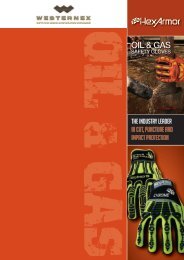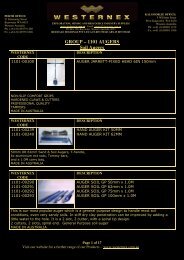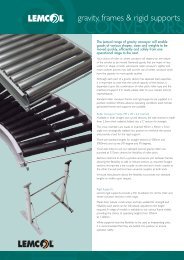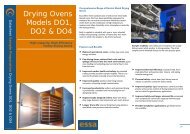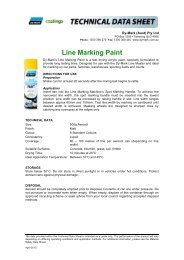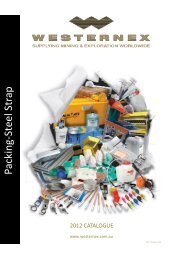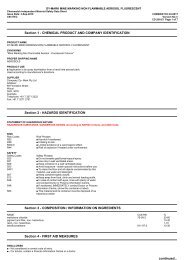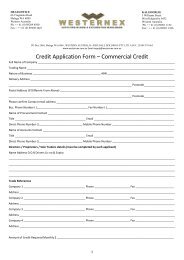Chemwatch Australian MSDS 42095 - Westernex
Chemwatch Australian MSDS 42095 - Westernex
Chemwatch Australian MSDS 42095 - Westernex
You also want an ePaper? Increase the reach of your titles
YUMPU automatically turns print PDFs into web optimized ePapers that Google loves.
DY-MARK SAFE MARK NON FLAMMABLE AEROSOL LEAD FREE COLOURS<br />
<strong>Chemwatch</strong> Independent Material Safety Data Sheet<br />
Issue Date: 7-Sep-2009 CHEMWATCH <strong>42095</strong><br />
C9317EC<br />
Version No:5<br />
CD 2009/2 Page 1 of 7<br />
Section 1 - CHEMICAL PRODUCT AND COMPANY IDENTIFICATION<br />
PRODUCT NAME<br />
DY-MARK SAFE MARK NON FLAMMABLE AEROSOL LEAD FREE COLOURS<br />
SYNONYMS<br />
"Steadfast Safety Spray All Colours", "safety marking ink"<br />
PROPER SHIPPING NAME<br />
AEROSOLS<br />
PRODUCT USE<br />
■ Application is by spray atomisation from a hand held aerosol pack.<br />
Non flammable aerosol spray marker paint for use in coal mines, as per approval<br />
letter QueenslandDepartment of Minerals and Energy.<br />
SUPPLIER<br />
Company: Dy- Mark Pty Ltd<br />
Address:<br />
89 Formation Street<br />
Wacol<br />
QLD, 4076<br />
AUS<br />
Telephone: +61 7 3271 2222<br />
Fax: +61 7 3271 2751<br />
Section 2 - HAZARDS IDENTIFICATION<br />
STATEMENT OF HAZARDOUS NATURE<br />
HAZARDOUS SUBSTANCE. DANGEROUS GOODS. According to the Criteria of NOHSC, and the ADG Code.<br />
POISONS SCHEDULE<br />
None<br />
RISK<br />
Risk Codes<br />
R04<br />
R22<br />
R38<br />
R40(3)<br />
SAFETY<br />
Safety Codes<br />
S36<br />
S401<br />
S13<br />
S46<br />
S60<br />
Risk Phrases<br />
■ Forms very sensitive explosive metallic compounds.<br />
■ Harmful if swallowed.<br />
■ Irritating to skin.<br />
■ Limited evidence of a carcinogenic effect.<br />
Safety Phrases<br />
■ Wear suitable protective clothing.<br />
■ To clean the floor and all objects contaminated by this<br />
material use water and detergent.<br />
■ Keep away from food drink and animal feeding stuffs.<br />
■ If swallowed IMMEDIATELY contact Doctor or Poisons<br />
Information Centre. (show this container or label).<br />
■ This material and its container must be disposed of as<br />
hazardous waste.<br />
Section 3 - COMPOSITION / INFORMATION ON INGREDIENTS<br />
NAME CAS RN %<br />
methylene chloride 75-09-2 30-60<br />
ethylene glycol monobutyl ether 111-76-2 1-10<br />
pigment and filler, non- hazardous 10-30<br />
resin, non- hazardous 1-10<br />
tetrafluoroethane 811-97-2 10-30<br />
continued...
DY-MARK SAFE MARK NON FLAMMABLE AEROSOL LEAD FREE COLOURS<br />
<strong>Chemwatch</strong> Independent Material Safety Data Sheet<br />
Issue Date: 7-Sep-2009 CHEMWATCH <strong>42095</strong><br />
C9317EC<br />
Version No:5<br />
CD 2009/2 Page 2 of 7<br />
Section 4 - FIRST AID MEASURES<br />
SWALLOWED<br />
■ - Not considered a normal route of entry.<br />
■ - For advice, contact a Poisons Information Centre or a doctor.<br />
■ - Avoid giving milk or oils.<br />
■ - Avoid giving alcohol.<br />
EYE<br />
■ If aerosols come in contact with the eyes:<br />
- Immediately hold the eyelids apart and flush the eye continuously for at least 15 minutes with fresh running water.<br />
- Ensure complete irrigation of the eye by keeping eyelids apart and away from eye and moving the eyelids by occasionally lifting the upper and lower<br />
lids.<br />
SKIN<br />
■ If solids or aerosol mists are deposited upon the skin:<br />
- Flush skin and hair with running water (and soap if available).<br />
- Remove any adhering solids with industrial skin cleansing cream.<br />
INHALED<br />
■ If aerosols, fumes or combustion products are inhaled:<br />
- Remove to fresh air.<br />
- Lay patient down. Keep warm and rested.<br />
NOTES TO PHYSICIAN<br />
■ for intoxication due to Freons/ Halons;<br />
A: Emergency and Supportive Measures<br />
- Maintain an open airway and assist ventilation if necessary<br />
- Treat coma and arrhythmias if they occur. Avoid (adrenaline) epinephrine or other sympathomimetic amines that may precipitate ventricular<br />
arrhythmias. Tachyarrhythmias caused by increased myocardial sensitisation may be treated with propranolol, 1-2 mg IV or esmolol 25-100<br />
microgm/kg/min IV.<br />
Followed acute or short term repeated exposures to ethylene glycol monoalkyl ethers and their acetates:<br />
- Hepatic metabolism produces ethylene glycol as a metabolite.<br />
- Clinical presentation, following severe intoxication, resembles that of ethylene glycol exposures.<br />
Treat symptomatically.<br />
For acute or short term repeated exposures to ethylene glycol:<br />
- Early treatment of ingestion is important. Ensure emesis is satisfactory.<br />
- Test and correct for metabolic acidosis and hypocalcaemia.<br />
Section 5 - FIRE FIGHTING MEASURES<br />
EXTINGUISHING MEDIA<br />
■ SMALL FIRE: Use extinguishing agent suitable for type of surrounding fire.<br />
LARGE FIRE: Cool cylinder.<br />
SMALL FIRE:<br />
- Water spray, dry chemical or CO2<br />
LARGE FIRE:<br />
- Water spray or fog.<br />
FIRE FIGHTING<br />
■ - Alert Fire Brigade and tell them location and nature of hazard.<br />
- May be violently or explosively reactive.<br />
When any large container (including road and rail tankers) is involved in a fire,<br />
consider evacuation by 100 metres in all directions.<br />
FIRE/EXPLOSION HAZARD<br />
■ - Non combustible.<br />
- Not considered to be a significant fire risk.<br />
Decomposition may produce toxic fumes of: carbon monoxide (CO), carbon dioxide (CO2), hydrogen chloride, phosgene, hydrogen fluoride, other pyrolysis<br />
products typical of burning organic material.<br />
Contains low boiling substance: Closed containers may rupture due to pressure buildup under fire conditions.<br />
FIRE INCOMPATIBILITY<br />
■ - Avoid contamination with oxidising agents i.e. nitrates, oxidising acids, chlorine bleaches, pool chlorine etc. as ignition may result.<br />
HAZCHEM: 2YE<br />
Personal Protective Equipment<br />
Gas tight chemical resistant suit.<br />
continued...
DY-MARK SAFE MARK NON FLAMMABLE AEROSOL LEAD FREE COLOURS<br />
<strong>Chemwatch</strong> Independent Material Safety Data Sheet<br />
Issue Date: 7-Sep-2009 CHEMWATCH <strong>42095</strong><br />
C9317EC<br />
Version No:5<br />
CD 2009/2 Page 3 of 7<br />
Section 6 - ACCIDENTAL RELEASE MEASURES<br />
MINOR SPILLS<br />
■ - Clean up all spills immediately.<br />
- Avoid breathing vapours and contact with skin and eyes.<br />
MAJOR SPILLS<br />
■ - Remove leaking cylinders to a safe place.<br />
- Fit vent pipes. Release pressure under safe, controlled conditions.<br />
- DO NOT exert excessive pressure on valve; DO NOT attempt to operate damaged valve.<br />
- Clear area of personnel and move upwind.<br />
- Alert Fire Brigade and tell them location and nature of hazard.<br />
Personal Protective Equipment advice is contained in Section 8 of the <strong>MSDS</strong>.<br />
Section 7 - HANDLING AND STORAGE<br />
PROCEDURE FOR HANDLING<br />
■ - Avoid all personal contact, including inhalation.<br />
- Wear protective clothing when risk of exposure occurs.<br />
SUITABLE CONTAINER<br />
■ - DO NOT use aluminium or galvanised containers.<br />
- Aerosol dispenser.<br />
- Check that containers are clearly labelled.<br />
STORAGE INCOMPATIBILITY<br />
■ Ethylene glycol monobutyl ether (2-butoxyethanol) and its acetate:<br />
- May form unstable peroxides in storage<br />
- is incompatible with oxidisers, permanganates, peroxides, ammonium persulfate, bromine dioxide, nitrates, strong acids, sulfuric acid, nitric acid,<br />
perchloric acid.<br />
Methylene chloride<br />
- is a combustible liquid under certain circumstances even though there is no measurable flash point and it is difficult to ignite<br />
- its is flammable in ambient air in the range 12-23%; increased oxygen content can greatly enhance fire and explosion potential.<br />
Haloalkanes:<br />
- are highly reactive:some of the more lightly substituted lower members are highly flammable; the more highly substituted may be used as fire<br />
suppressants, not always with the anticipated results.<br />
- may react with the lighter divalent metals to produce more reactive compounds analogous to Grignard reagents.<br />
- Segregate from alcohol, water.<br />
- Compressed gases may contain a large amount of kinetic energy over and above that potentially available from the energy of reaction produced by the<br />
gas in chemical reaction with other substances.<br />
STORAGE REQUIREMENTS<br />
■ - Keep dry to avoid corrosion of cans. Corrosion may result in container perforation and internal pressure may eject contents of can.<br />
Section 8 - EXPOSURE CONTROLS / PERSONAL PROTECTION<br />
EXPOSURE CONTROLS<br />
Source Material TWA ppm TWA mg/m³ STEL ppm STEL mg/m³ Notes<br />
___________ ___________ _______ _______ _______ _______ _______<br />
Australia Exposure methylene chloride 50 174 Sk<br />
Standards<br />
(Methylene chloride)<br />
Australia Exposure ethylene glycol 20 96.9 50 242 Sk<br />
Standards monobutyl ether (2-<br />
Butoxyethanol)<br />
Australia Exposure tetrafluoroethane (1, 1000 4240<br />
Standards 1, 1, 2-<br />
Tetrafluoroethane)<br />
PERSONAL PROTECTION<br />
RESPIRATOR<br />
Type AXNO Filter of sufficient capacity<br />
EYE<br />
■ No special equipment for minor exposure i.e. when handling small quantities.<br />
HANDS/FEET<br />
■ - No special equipment needed when handling small quantities.<br />
- OTHERWISE:<br />
continued...
DY-MARK SAFE MARK NON FLAMMABLE AEROSOL LEAD FREE COLOURS<br />
<strong>Chemwatch</strong> Independent Material Safety Data Sheet<br />
Issue Date: 7-Sep-2009 CHEMWATCH <strong>42095</strong><br />
C9317EC<br />
Version No:5<br />
OTHER<br />
■ No special equipment needed when handling small quantities.<br />
OTHERWISE:<br />
- Overalls.<br />
- Skin cleansing cream.<br />
ENGINEERING CONTROLS<br />
■ General exhaust is adequate under normal conditions. If risk of overexposure exists, wear SAA approved respirator.<br />
CD 2009/2 Page 4 of 7<br />
Section 8 - EXPOSURE CONTROLS / PERSONAL PROTECTION<br />
Section 9 - PHYSICAL AND CHEMICAL PROPERTIES<br />
APPEARANCE<br />
Volatile coloured liquid with an ether-like odour; does not mix with water.<br />
Contents under pressure. Supplied in aerosol pack containing non flammable<br />
propellant.<br />
PHYSICAL PROPERTIES<br />
Liquid.<br />
Gas.<br />
Does not mix with water.<br />
Sinks in water.<br />
Molecular Weight: Not Applicable Boiling Range (°C): 40<br />
Melting Range (°C): Not Available<br />
Specific Gravity (water=1): 1.1 approx.<br />
Solubility in water (g/L): Immiscible<br />
pH (as supplied): Not Applicable<br />
pH (1% solution): Not Applicable<br />
Vapour Pressure (kPa): Not available<br />
Volatile Component (%vol): >60<br />
Evaporation Rate: Not Available<br />
Relative Vapour Density (air=1): >1<br />
Flash Point (°C): Not Applicable<br />
Lower Explosive Limit (%): Not Applicable<br />
Upper Explosive Limit (%): Not Applicable<br />
Autoignition Temp (°C): Not Available<br />
Decomposition Temp (°C): Not Available<br />
State: Liquid<br />
Viscosity: Not Available<br />
Section 10 - CHEMICAL STABILITY AND REACTIVITY INFORMATION<br />
CONDITIONS CONTRIBUTING TO INSTABILITY<br />
■ - Elevated temperatures.<br />
- Presence of open flame.<br />
For incompatible materials - refer to Section 7 - Handling and Storage.<br />
Section 11 - TOXICOLOGICAL INFORMATION<br />
POTENTIAL HEALTH EFFECTS<br />
ACUTE HEALTH EFFECTS<br />
■ Harmful if swallowed.<br />
■ Irritating to skin.<br />
■ Vapours may cause dizziness or suffocation.<br />
CHRONIC HEALTH EFFECTS<br />
■ Limited evidence of a carcinogenic effect.<br />
TOXICITY AND IRRITATION<br />
■ unless otherwise specified data extracted from RTECS - Register of Toxic Effects of Chemical Substances.<br />
■ The material may produce moderate eye irritation leading to inflammation. Repeated or prolonged exposure to irritants may produce conjunctivitis.<br />
The material may produce severe skin irritation after prolonged or repeated exposure, and may produce a contact dermatitis (nonallergic). This form<br />
of dermatitis is often characterised by skin redness (erythema) thickening of the epidermis.<br />
METHYLENE CHLORIDE:<br />
■ unless otherwise specified data extracted from RTECS - Register of Toxic Effects of Chemical Substances.<br />
TOXICITY IRRITATION<br />
Oral (human) LDLo: 357 mg/kg<br />
Skin (rabbit): 810 mg/24hr- SEVERE<br />
Oral (rat) LD50: 1600 mg/kg<br />
Skin (rabbit): 100mg/24hr- Moderate<br />
Inhalation (human) TCLo: 500 ppm/ 8 hr<br />
Eye(rabbit): 162 mg - Moderate<br />
Inhalation (rat) LC50: 88000 mg/m³/30 m<br />
Eye(rabbit): 500 mg/24hr - Mild<br />
■ The material may produce moderate eye irritation leading to inflammation. Repeated or prolonged exposure to irritants may produce conjunctivitis.<br />
The material may produce severe skin irritation after prolonged or repeated exposure, and may produce a contact dermatitis (nonallergic). This form<br />
of dermatitis is often characterised by skin redness (erythema) thickening of the epidermis.<br />
WARNING: This substance has been classified by the IARC as Group 2B: Possibly Carcinogenic to Humans.<br />
Inhalation (human) TCLo: 500 ppm/ 1 y - I Eye(rabbit): 10 mg - mild<br />
ETHYLENE GLYCOL MONOBUTYL ETHER:<br />
■ unless otherwise specified data extracted from RTECS - Register of Toxic Effects of Chemical Substances.<br />
TOXICITY<br />
IRRITATION<br />
continued...
DY-MARK SAFE MARK NON FLAMMABLE AEROSOL LEAD FREE COLOURS<br />
<strong>Chemwatch</strong> Independent Material Safety Data Sheet<br />
Issue Date: 7-Sep-2009 CHEMWATCH <strong>42095</strong><br />
C9317EC<br />
Version No:5<br />
CD 2009/2 Page 5 of 7<br />
Section 11 - TOXICOLOGICAL INFORMATION<br />
Oral (rat) LD50: 470 mg/kg Skin (rabbit): 500 mg, open; Mild<br />
Dermal (rabbit) LD50: 220 mg/kg<br />
Eye (rabbit): 100 mg/24h- Moderate<br />
Inhalation (human) TCLo: 100 ppm<br />
Eye (rabbit): 100 mg SEVERE<br />
Inhalation (human) TCLo: 195 ppm/8h * [Union Carbide]<br />
Inhalation (Rat) LC50: 450 ppm *<br />
■ The material may produce severe irritation to the eye causing pronounced inflammation. Repeated or prolonged exposure to irritants may produce<br />
conjunctivitis.<br />
The material may cause skin irritation after prolonged or repeated exposure and may produce a contact dermatitis (nonallergic). This form of<br />
dermatitis is often characterised by skin redness (erythema) and swelling epidermis.<br />
For ethylene glycol:<br />
Ethylene glycol is quickly and extensively absorbed through the gastrointestinal tract. Limited information suggests that it is also absorbed through<br />
the respiratory tract; dermal absorption is apparently slow.<br />
For ethylene glycol monoalkyl ethers and their acetates (EGMAEs):<br />
Typical members of this category are ethylene glycol propylene ether (EGPE), ethylene glycol butyl ether (EGBE) and ethylene glycol hexyl ether<br />
(EGHE) and their acetates<br />
EGMAEs are substrates for alcohol dehydrogenase isozyme ADH-3, which catalyzes the conversion of their terminal alcohols to aldehydes (which are<br />
transient metabolites). Further, rapid conversion of the aldehydes by aldehyde dehydrogenase produces alkoxyacetic acids, which are the predominant<br />
urinary metabolites of mono substituted glycol ethers.<br />
Exposure of pregnant rats to ethylene glycol monobutyl ether (2-butoxyethanol) at 100 ppm or rabbits at 200 ppm during organogenesis resulted in<br />
maternal toxicity and embryotoxicity including a decreased number of viable implantations per litter. Slight foetoxicity in the form of poorly<br />
ossified or unossified skeletal elements was also apparent in rats.<br />
NOTE: Changes in kidney, liver, spleen and lungs are observed in animals<br />
exposed to high concentrations of this substance by all routes.<br />
TETRAFLUOROETHANE:<br />
■ unless otherwise specified data extracted from RTECS - Register of Toxic Effects of Chemical Substances.<br />
TOXICITY<br />
IRRITATION<br />
Inhalation (Rat) LC50: 1500000 mg/m³/4h<br />
Inhalation (Mouse) LC50: 1700000 mg/m³/2h<br />
Inhalation (Rat) LC50: >80% vol 15 mins *<br />
Inhalation (Rat) LC50: >60% vol 4 h *<br />
* with added oxygen - ZhongHao New Chemical Materials <strong>MSDS</strong><br />
Excessive concentration can have a narcotic effect; inhalation of high<br />
concentrations of decomposition products can cause lung oedema.<br />
CARCINOGEN<br />
Dichloromethane International Agency for Research on Cancer Group 2B<br />
(methylene chloride)<br />
(IARC) Carcinogens<br />
Australia Exposure Standards - Carcinogens Carcinogen Category 3<br />
2- Butoxyethanol International Agency for Research on Cancer Group 3<br />
(IARC) Carcinogens<br />
REPROTOXIN<br />
methylene chloride ILO Chemicals in the electronics industry Reduced fertility or<br />
that have toxic effects on reproduction<br />
sterility<br />
SKIN<br />
methylene chloride Australia Exposure Notes Sk<br />
Standards - Skin<br />
ethylene glycol Australia Exposure Notes Sk<br />
monobutyl ether<br />
Standards - Skin<br />
Section 12 - ECOLOGICAL INFORMATION<br />
This material and its container must be disposed of as hazardous waste.<br />
Ecotoxicity<br />
Ingredient Persistence: Persistence: Bioaccumulat Mobility<br />
Water/Soil Air ion<br />
Dy- Mark Safe Mark Non Flammable<br />
No data<br />
Aerosol Lead Free Colours<br />
methylene chloride<br />
No data<br />
ethylene glycol monobutyl ether<br />
No data<br />
tetrafluoroethane<br />
No data<br />
Section 13 - DISPOSAL CONSIDERATIONS<br />
■ - DO NOT allow wash water from cleaning or process equipment to enter drains.<br />
- It may be necessary to collect all wash water for treatment before disposal.<br />
- Consult State Land Waste Management Authority for disposal.<br />
- Discharge contents of damaged aerosol cans at an approved site.<br />
continued...
DY-MARK SAFE MARK NON FLAMMABLE AEROSOL LEAD FREE COLOURS<br />
<strong>Chemwatch</strong> Independent Material Safety Data Sheet<br />
Issue Date: 7-Sep-2009 CHEMWATCH <strong>42095</strong><br />
C9317EC<br />
Version No:5<br />
CD 2009/2 Page 6 of 7<br />
Section 14 - TRANSPORTATION INFORMATION<br />
Labels Required: NON-FLAMMABLE COMPRESSED GAS<br />
HAZCHEM: 2YE (ADG7)<br />
ADG7:<br />
Class or division: 2 Subsidiary risk: None<br />
UN No.: 1950 UN packing group: None<br />
Special provisions: 63, 190, 277, 327 Packing Instructions: None<br />
Notes: None Limited quantities: See SP 277<br />
Portable tanks and bulk None Portable tanks and bulk None<br />
containers -<br />
containers - Special<br />
Instructions:<br />
provisions:<br />
Packagings and IBCs - P003, LP02 Packagings and IBCs - PP17, PP87, L2<br />
Packing instruction:<br />
Special packing<br />
provisions:<br />
Shipping Name:AEROSOLS<br />
Land Transport UNDG:<br />
Class or division: 2 Subsidiary risk: None<br />
UN No.: 1950 UN packing group: None<br />
Shipping Name:AEROSOLS<br />
Air Transport IATA:<br />
Maritime Transport IMDG:<br />
IMDG Class: 2.2 IMDG Subrisk: SP63<br />
UN Number: 1950 Packing Group: None<br />
EMS Number: F- D, S- U Special provisions: 63 190 277 327 959<br />
Limited Quantities: See SP277 Marine Pollutant: Not Determined<br />
Shipping Name: AEROSOLS<br />
Section 15 - REGULATORY INFORMATION<br />
POISONS SCHEDULE: None<br />
REGULATIONS<br />
Regulations for ingredients<br />
methylene chloride (CAS: 75-09-2) is found on the following regulatory lists;<br />
"Australia - <strong>Australian</strong> Capital Territory - Environment Protection Regulation: Ambient environmental standards (Domestic water supply - organic compounds)","Australia - <strong>Australian</strong> Capi<br />
Environment Protection Regulation: Pollutants entering waterways taken to cause environmental harm (Aquatic habitat)","Australia - <strong>Australian</strong> Capital Territory Environment Protection R<br />
Ecosystem maintenance - Organic chemicals - Non-pesticide anthropogenic organics","Australia - <strong>Australian</strong> Capital Territory Environment Protection Regulation Pollutants entering wate<br />
water quality","Australia Exposure Standards","Australia Hazardous Substances","Australia High Volume Industrial Chemical List (HVICL)","Australia National Pollutant Inventory","Austra<br />
for the Uniform Scheduling of Drugs and Poisons (SUSDP) - Appendix E (Part 2)","Australia Standard for the Uniform Scheduling of Drugs and Poisons (SUSDP) - Appendix F (Part 3)","A<br />
for the Uniform Scheduling of Drugs and Poisons (SUSDP) - Appendix I","Australia Standard for the Uniform Scheduling of Drugs and Poisons (SUSDP) - Schedule 5","IMO MARPOL 73<br />
Noxious Liquid Substances Carried in Bulk","International Agency for Research on Cancer (IARC) Carcinogens","International Council of Chemical Associations (ICCA) - High Production<br />
Representative List of High Production Volume (HPV) Chemicals","WHO Guidelines for Drinking-water Quality - Guideline values for chemicals that are of health significance in drinking-w<br />
ethylene glycol monobutyl ether (CAS: 111-76-2) is found on the following regulatory lists;<br />
"Australia Exposure Standards","Australia Hazardous Substances","Australia High Volume Industrial Chemical List (HVICL)","IMO MARPOL 73/78 (Annex II) - List of Other Liquid Substa<br />
Agency for Research on Cancer (IARC) Carcinogens","OECD Representative List of High Production Volume (HPV) Chemicals"<br />
tetrafluoroethane (CAS: 811-97-2) is found on the following regulatory lists;<br />
"Australia Exposure Standards","Australia Hazardous Substances","Australia High Volume Industrial Chemical List (HVICL)","OECD Representative List of High Production Volume (HPV<br />
No data for Dy-Mark Safe Mark Non Flammable Aerosol Lead Free Colours (CW: <strong>42095</strong>)<br />
Section 16 - OTHER INFORMATION<br />
■ Classification of the preparation and its individual components has drawn on official and authoritative sources as well as independent review by<br />
the <strong>Chemwatch</strong> Classification committee using available literature references.<br />
A list of reference resources used to assist the committee may be found at:<br />
www.chemwatch.net/references.<br />
■ The (M)SDS is a Hazard Communication tool and should be used to assist in the Risk Assessment. Many factors determine whether the reported Hazards<br />
are Risks in the workplace or other settings.<br />
This document is copyright. Apart from any fair dealing for the purposes of private study, research, review or<br />
criticism, as permitted under the Copyright Act, no part may be reproduced by any process without written<br />
permission from CHEMWATCH. TEL (+61 3) 9572 4700.<br />
Issue Date: 7-Sep-2009<br />
Print Date: 10-Sep-2009<br />
continued...
DY-MARK SAFE MARK NON FLAMMABLE AEROSOL LEAD FREE COLOURS<br />
<strong>Chemwatch</strong> Independent Material Safety Data Sheet<br />
Issue Date: 7-Sep-2009 CHEMWATCH <strong>42095</strong><br />
C9317EC<br />
Version No:5<br />
This is the end of the <strong>MSDS</strong>.<br />
CD 2009/2 Page 7 of 7<br />
Section 16 - OTHER INFORMATION




